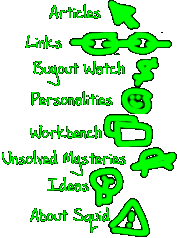

Welcome to another exciting episode of Unsolved Mysteries. I'm your host, Robert Stack.
Since I'm in a hurry to get this thing moving, I'll just post one mystery for now.
In 1994, Commodore died. (Big news.) When they fell, with them went all the advanced Amiga development still in progress - the RISC architecture stuff, PCI systems, Hombre, the various DSP and graphics card projects, new operating systems, and most importantly, AAA.
AAA was originally conceived in 1987, as a next-generation Amiga architecture when it became clear the original Amiga chipset would not be state of the art forever. Systems like IBM's PS/2 and the Apple Macintosh II were beating the Amiga in terms of color displays - 256 colors onscreen out of 262,144 in 320x200 on the PS/2 and 256 colors out of sixteen million in 640x480 on the Mac II, were knocking the pants off 32 colors out of 4096 in 320x400 on the Amiga - and the "trick" HAM mode was at once better and worse than 256 color modes. AAA began as little more than a hypothetical "Wouldn't it be cool if." As far back as 1987, RJ Mical and others were publicly mentioning a future Amiga chipset capable of 1024x1024 in 256 colors.
But reality was a different story. The Amiga chipset was modified only twice between 1985 and 1990 - the "VLSI upgrade" Denise in 1986 that added halfbrite, and the Enhanced Chip Set of the A3000 in 1990 that added Productivity (31KHz) screenmodes, Super High Res (1280x200, 1280x400), border blanking and sprite-in-border, tweakable frequencies, and upped the Chip RAM to 2MB. Colors were still stuck at 4096. High resolutions were still limited to 16 colors. Sound could be kicked to a higher sampling rate ONLY if the screenmode was set to Productivity - one of the more bizarre side-effects of the Amiga's tightly coupled architecture. But the core of the Amiga's graphical heart had remained largely unchanged since the original Lorraine breadboard closet-sized hardwire prototypes in 1984.
In 1990 Commodore finally bit the bullet and said "Let's revamp the Amiga chipset." AAA, the Advanced Amiga Architecture, went from being an abstract "What if we could make the Amiga do this?" to a work in progress. It quickly became clear AAA would not come quickly - it would be at least 1992 before a working Amiga based on AAA could hit store shelves - but the marketplace needed something in the meantime. So someone had the idea to build an intermediate chipset, called AA, to at least bring the Amiga up to 1990 standards while they worked on the much more advanced AAA. AA would feature increased color depth in all screen resolutions, plus several high-scan-rate screen modes for use on multiscan monitors - again, no change to the Paula sound chip, no change to the floppy controller, the entire system was still based on the same old pixel clock, etc. But hopefully no one would complain after using eight-bitplane HAM modes (for 262,144 colors simultaneously and beyond) - giving Ed Hepler and the rest of the AAA miracle-workers time to roll out AAA. Dave Haynie, Greg Berlin and others began building a new modular Amiga from the A3000 architecture, putting the first AA chips in it and adding things like the superfast 68040 processor and an AT&T 3210 digital signal processor.
Then tragedy struck - or more precisely, Mehdi Ali.
Ali fired Dr. Henri Rubin, head of engineering, and replaced him with Bill Sydnes, formerly with IBM, the "genius" responsible for such landmark successes as the PCjr. Needless to say, the idea of something as modern as AA didn't set well with him - particularly since it was a product of the previous administration - and as we all know, one of the jobs of new management is to erase all evidence of the previous administration. So AA was cancelled, AAA put even farther back on the burner, and all of a sudden everyone's busy making Sydnes' "toy" Amigas.
Needless to say, the A600 (a 68000, ECS machine in a dinky C64-like case and limited expansion but with a $700 price tag that was $100 more than the A500) went over like a lead balloon, especially since they discontinued the top-selling A500 in hopes of "encouraging" people to buy the A600 instead. The A1000+, which by all accounts would have been an underpowered and overpriced A3000 without the expansion, was cancelled the day they finished the prototype - Commodore's distributors and salespeople saw it and said "There's no way in hell we can sell that piece of shit." The CDTV was a technical success in some respects (brand new for the blossoming CD-ROM entertainment market) but failed commercially because no one really knew what it was supposed to be - the "stealth computer" thing worked all too well. Not to mention it was the last Amiga to still use Kickstart 1.3...
Finally Sydnes was all out of stupid ideas, and he finally shrugged and said, "OK, let's see you guys do better."
The A3000+ was no longer feasible. They were on a tight schedule and there were bugs in the DSP system that needed fixing, amongst other problems. They had the AA (now called AGA) chipset working more or less, they had the 68030 motherboard of the 1000+, they had the 3640 68040 accelerator for the A3000, they had a way to shoehorn the AGA chips onto the 1000+'s ECS motherboard, and they were able to slap together an AGA system on short notice in 1992.
Amiga lovers went crazy over the awesome A4000 - a 68040 processor, unlimited RAM, Kickstart 3.0, the high-density floppy drive, and the long-awaited 256 color chipset. Never mind the 68040 was clocked a few MHz different than the motherboard - 25MHz instead of 28MHz - and the memory architecture was designed for a 68030, less than optimal for the 68040. Kickstart 3.0 was a work in progress - all the retargetable stuff they hoped to add wasn't done in time, the new Datatypes feature was a memory hog, it was more like 2.2 than 3.0. The high-density floppy drive was painfully slow - the disk controller in the chipset couldn't handle disk access at double speed so they had to just cut the motor speed in half instead. And anyone who's used a 256 color Workbench on the AGA chipset, even with a fast processor, will tell you exactly how wonderful sluggish screen redraws can be. The A4000 was good, but it could have been much better - and this fact was not lost on Commodore's engineers.
AAA was again on the table. While the A4000 was on its own rollercoaster (thanks to Sydnes' inability to order enough parts to build them) Ed Hepler and others were back at work on the stunning new chipset. In addition to the expected 24-bit modes and higher resolutions, they built in speed increases and other cool things. They added HAM10 modes - for 24-bit color that used only as much memory as two 32-color screens. They added support for chip RAM up to 8MB. They added a floppy controller that could drive high density floppies - even the EHD kind, at 3.5MB - at full speed. Sound went up to full 16 bit, eight voice, 44KHz - basically CD-quality. Graphics resolutions hit 1024x768 and beyond. The copper could feed the blitter - thus doing animations while the main processor sat idle. Best of all, the chipset could be "doubled" - a motherboard could be built with TWO apiece of several chips for a 64-bit graphics architecture.
By 1994, two AAA motherboards existed, the "Nyx" systems. The initial silicon run of AAA was something like 94% operational - there were some serious flaws in one of the chips that would take a few months to iron out in time for the final silicon run. One of the motherboards didn't work, and the other one worked well enough to give the graphics a test run but it couldn't boot Workbench.
Then April 29 rolled around. Commodore's international parent company finally collapsed under Mehdi Ali's weight. The layoffs at the West Chester plant were ridiculous - something like 40 people remained. What was left at West Chester had no funds with which to actually build anything - AAA moved at a snail's pace, almost transistor by transistor.
Finally, in the summer of 1994, the remnants of Commodore Engineering relocated to nearby Norristown, Pennsylvania. What exactly they were doing in those days is not known - probably mostly resume polishing and some cost-reduction on CD32. And of course, the usual Commodore engineering antics like overclocking chips until they explode.
Dave Haynie somehow wound up with one of the A3000+ prototypes - probably swiped during the filming of the Deathbed Vigil. But those two AAA motherboards we saw on his desk are missing in action.
When ESCOM swooped in like a phoenix (or a vulture) in 1995, they bought up everything Commodore, but we never heard word one about AAA. No one seems to know where those two motherboards went. The chips were unfinished - the boards themselves lacked several components since they were just prototypes - and one of the boards didn't appear to work at all. If anyone swiped those boards during Commodore's last days, they wouldn't have gotten much use of them.
Still, it would be nice to know for history's sake where those boards went.
[John's Homepage]
[Sarah McLachlan Stuff]
[Donna Lewis]
[Cabinet of Curiosities]
[About John]
[John's Art]
[Email John]
[Guestbook]